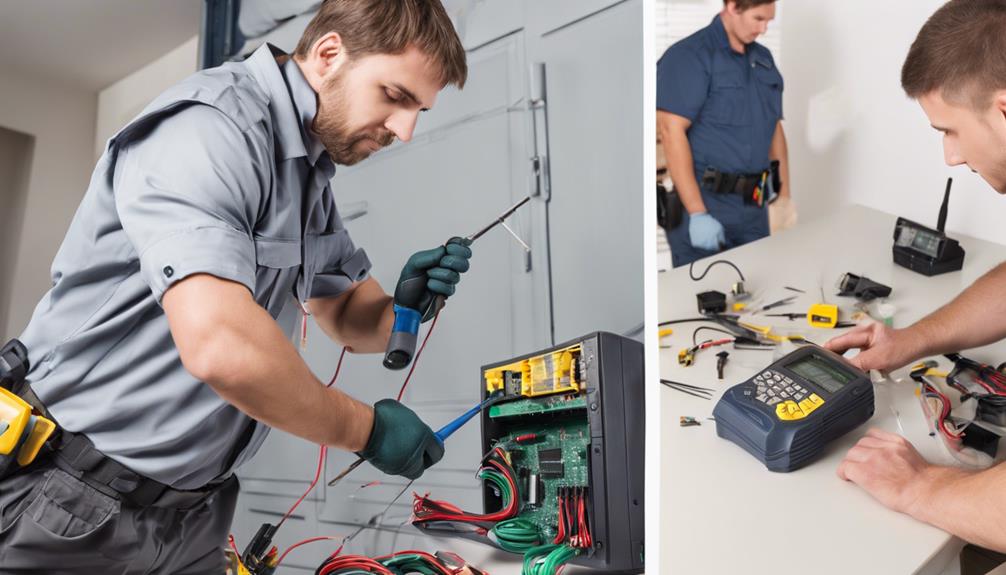When deciding between professional or DIY security system installations, consider the cost differences and customization options. DIY systems generally have lower upfront costs, but require more hands-on setup, while professional installations come with expert placement but at a higher price. You may enjoy the flexibility of DIY systems in designing your security setup to your preferences, but professionals offer immediate support and thorough monitoring services. The choice between the two depends on your budget and preference for customization versus expert assistance.
Key Takeaways
- DIY systems offer cost-effectiveness and customization.
- Professional installations ensure expert setup and ongoing monitoring.
- DIY solutions may lack immediate support and troubleshooting.
- Professional systems may have higher overall costs and fees.
- DIY systems provide flexibility in component selection and tailored security.
Cost and Financial Considerations

When considering security system installations, the costs and financial implications play an essential role in decision-making. If you opt for a DIY system, you can expect to start at around $200, with total costs varying between $100 and $500.
On the other hand, professional installations typically come with higher upfront costs, including installation fees ranging from $200 to $1,000. Keep in mind that professional monitoring fees for companies like ADT and Vivint usually start around $19.99 and $29.99 per month, respectively.
However, DIY systems often offer self-monitoring options with no ongoing fees, resulting in average monthly monitoring costs of about $28.05 for DIY systems compared to $50.08 for professional systems.
Additionally, DIY vs. Professional Security Systems provide insights suggesting that DIY systems offer more flexibility and customization without requiring long-term contracts, while professional systems often entail multi-year agreements, ultimately leading to higher overall costs.
Installation and Setup Processes

For those considering installing a security system, understanding the installation and setup processes is crucial.
DIY installation usually takes between 30 minutes to 2 hours, involving tasks like hub setup, sensor pairing, and testing. DIY systems offer considerable flexibility and can be customized to match specific needs, but this comes at the cost of potentially higher effort and complexity.
On the other hand, professional installation may require scheduling and includes a starting fee of around $100. DIY systems often use wireless technology, making setup easier but potentially challenging for non-tech-savvy users.
Professionals, however, guarantee optimal equipment placement and functionality. DIY systems offer user-friendly app guidance, but improper placement is a risk without professional oversight.
Professional installations include thorough support and troubleshooting. They assess security needs meticulously, optimizing equipment placement better than DIY systems.
DIY installations need careful planning, as time estimates can be underestimated for larger homes. Professionals may provide same-day service, reducing activation wait times.
Consider these differences when deciding between professional installation benefits and DIY setups.
Monitoring and Support Options

Considering the monitoring and support options is essential when choosing between professional and DIY security system installations.
Professional monitoring services offer 24/7 monitoring with immediate assistance during emergencies, guaranteeing rapid response times critical for safety. Additionally, professional systems often include features like cellular backup, which guarantees the system remains operational even if the internet connection is disrupted.
On the other hand, DIY monitoring typically allows for self-monitoring without ongoing fees but may lack immediate support during crises. Professional systems come with dedicated support teams for troubleshooting, while DIY systems may offer limited customer service options, often through online channels or phone support.
Both DIY and professional systems implement encryption and multi-factor authentication to protect against internet hacking, but professional systems may have more advanced security protocols.
Additionally, professional systems usually provide thorough support and extended warranties, like Brinks Home's two-year warranty, while DIY systems may have shorter return policies and varying warranty terms.
When deciding between professional and DIY security installations, consider the level of monitoring and support necessary for your peace of mind and security needs.
Pros and Cons of Each System Type

Exploring the pros and cons of professional and DIY security system installations sheds light on the distinct advantages and limitations that each option presents.
When considering DIY security systems, here are some key points to keep in mind:
- Cost-Effectiveness: DIY systems are generally more budget-friendly, allowing for savings on installation fees compared to professional systems. Additionally, DIY options often feature lower monthly fees, making them an attractive choice for budget-conscious homeowners.
- Customization and Flexibility: DIY setups offer greater customization options, enabling users to tailor their security solutions to their specific needs and easily modify components over time. This flexibility can be particularly beneficial for those who anticipate moving or upgrading their system periodically.
- Limited Support: DIY systems may lack the extensive support available with professional setups, potentially leaving users without immediate troubleshooting help in case of technical issues.
On the other hand, professional security systems have their own set of pros and cons, such as expert installation ensuring peak functionality but at a higher cost and ongoing monitoring services for immediate assistance, contrasting with self-monitoring options common in DIY systems.
Customization and Features

When it comes to customization and features, DIY security systems offer homeowners a level of flexibility and personalization that may not be matched by professional installations.
DIY systems allow you to customize your home security setup by selecting specific devices and sensors tailored to your needs, enhancing both efficiency and effectiveness. Brands like Ring and SimpliSafe offer flexible package options, letting you add or remove components as your security requirements evolve. This level of customization guarantees your system caters to your unique home layout and security concerns, potentially increasing your overall satisfaction.
Additionally, many DIY systems come with user-friendly apps that allow you to monitor and control your system remotely, adding an extra layer of convenience. While professional systems may offer more advanced features like smart home integration, DIY options are catching up by becoming compatible with devices such as Google Assistant and Amazon Alexa, providing enhanced functionality.
Frequently Asked Questions
Is It Better to Install Your Own Security System?
When deciding whether to install your own security system, consider your comfort level with technology and ability to follow instructions accurately.
DIY setups can save money upfront and offer customization options, but they require proper planning and may take longer for larger homes.
Professional installations guarantee ideal setup and may be worth the extra cost for those seeking expert guidance and peace of mind.
Are DIY Home Security Systems Good?
DIY home security systems can be a great option for you. They offer flexibility, budget-friendly prices, and easy installation that you can handle in no time.
With DIY systems, you get to customize and expand your security setup at your own pace. While they may lack immediate support compared to professional services, they can still provide you with essential security features without ongoing fees.
What Are the Benefits of Professional Security System Installation?
When you opt for professional security system installation, you gain expert setup and configuration by trained technicians.
They guarantee ideal equipment placement for maximum effectiveness. The all-encompassing packages often include ongoing support and maintenance services, providing peace of mind.
The installation fees, averaging between $99 and $199, are offset by time saved and assurance of a correctly installed system.
With a tailored security assessment, your system meets your specific needs for enhanced security coverage.
What Is the Difference Between ADT and DIY?
When you compare ADT to a DIY security system, you'll notice that ADT offers professional installation with a cost ranging from $150 to $200, while DIY setups are self-installed at no extra charge.
ADT requires long contracts for monitoring at about $46 monthly, but DIY options start at $20 with no contract.
ADT provides 24/7 monitoring with expert help, while DIY systems need you to set up things on your own.
Conclusion
In the end, whether you choose a professional or DIY security system installation, it ultimately comes down to your personal preferences, budget, and technical abilities. Professionals offer peace of mind and expertise, while DIY options provide flexibility and cost savings. Consider your needs and priorities carefully before making a decision, and remember that the most important thing is to have a system in place that helps keep you and your loved ones safe.









